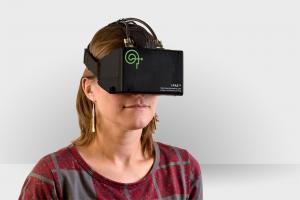NEURO KINETICS, INC. AWARDED 25TH PATENT
Got the Silver … Going for Gold
NKI’s FDA-cleared I-PAS™ is a compact, lightweight, head-mounted test system that measures neuro-functional performance with exceptional sensitivity. It can be used in almost any environment; is non-invasive; uses 4-D eye-tracking technology; measures binocular eye data in real-time; and provides stimulus feedback to run an extensive set of oculomotor, vestibular and reaction time (OVRT) tests, the majority of which are FDA-cleared for use by healthcare professionals responsible for measuring neuro-functional deficits.
This new patent, titled “Portable Goggle-based VOG System with Comparative Left- And Right-Eye Ocular Response Analysis With mTBI Analysis Using Percent of Saccade Function of Smooth Pursuit Test,” ups NKI’s U.S. patent portfolio to an impressive 25. The patent covers both hardware and software aspects of NKI’s state-of-the-art eye-tracking systems necessary to execute the associated tests. No other device manufacturer has NKI’s extensive battery of OVRT tests to comprehensively evaluate one’s neuro-functional performance.
NKI began marketing its head-mounted I-PAS™ System after receiving FDA clearance as a Class II medical device in November 2018. I-PAS™ is portable, does not require a dark room, provides high-resolution clinical data, and is easy to use.
“The technology protected by this new patent provides more precise information for clinicians, helping them identify and quantify their patients’ deficits and monitor their recovery progress. This technology is particularly helpful for concussion patients,” explained Dr. Alex Kiderman, Chief Technology Officer for NKI. "This patent covers the ability to map pupil response details for each eye separately,” he continued, “including amplitude, constriction velocity, constriction and dilation acceleration, and maximum pupil dilation. It gives the clinician a uniquely informative set of ophthalmic and neuro-functional information."
This patent also lists techniques for identifying and measuring: the saccadic(1) (jumpy) movements of one’s eye(s) in a smooth pursuit test, as well as micro-saccades; corrective or secondary saccades; and reaction times. NKI’s extensive data set enables clinicians to precisely measure neuro-functional performance. The metrics can be used not only to help identify concussion patients, but also to profile and quantify the abilities of superior athletes, monitor neuro-functional improvements or changes, or to help rehabilitate and train subjects or patients.
NKI’s I-Portal® technology captures each pupil movement separately at a rate of 100+ frames per second with a position sensitivity of .01 degrees. This level of resolution begins to match the signal processing of the brain and exceeds the ability of the naked eye to observe, or what NKI refers to as ‘The Science to See™.’ A clinician can now objectively measure and observe the subtle differences between controls and patient. Further, many studies have mapped the pathways/sections of the brain engaged in the execution of these tests. A physician may now better detect the specific areas of the brain affected by mTBI, ultimately helping therapists and other health care providers design and implement more effective rehabilitation protocols.
A wide range of medical professionals — including neurotologists, audiologists, chiropractic neurologists, neuro-ophthalmologists, physical therapists, and sports medicine specialists — are currently using NKI’s I-PAS™. Important professional sports users such as INDYCAR have integrated I-PAS™ into their concussion evaluation protocols. Healthcare professionals rely on I-PAS™ to monitor neurologic functions by measuring eye position, pupil response, conjugate reflexes, and reaction time, and use these measurements to provide a detailed window into the performance of the brain, and ultimately, their patients’ health.
ABOUT NKI
Neuro Kinetics, Inc. (NKI) is the leader in clinical eye tracking and non-invasive neuro-functional diagnostics and monitoring, offering technology that identifies abnormal eye responses connected to more than 200 diseases and medical conditions. With more than 150 installations, NKI’s FDA-cleared I-Portal® devices are sold to physical therapists, audiologists, ENTs, neurotologists, neuro-chiropractors, neuro-ophthalmologists, and neurologists around the globe. The company's FDA-cleared diagnostic platforms include the I-PAS™ (I-Portal® Portable Assessment System), I-Portal® NOTC (Neuro-Otologic Test Center), I-Portal® VNG, (Video Nystagmography) and I-Portal® VOG (Video Oculography), along with related accessories, software, training, and support services. To learn more, please refer to the RESOURCES page on NKI’s website (www.neuro-kinetics.com) for research on the role of I-Portal® in various concussion, vestibular, and other studies.
_____________________________
(1) Saccades are rapid movements of the eyes when an eye abruptly changes its point of fixation. They range from micro movements made while reading, to much larger movements, such as when a person jumps their focus from one object to another around a room. Saccades can be elicited voluntarily, but occur reflexively. Eye movement to a target takes about 200 milliseconds to initiate. During this delay, the position of the target (with respect to the distance the eye must move between the start position and new position[s]) is measured. (Neuroscience. 2nd edition. Purves D, Augustine GJ, Fitzpatrick D, et al., 2001).
Susan Zelicoff
Neuro Kinetics, Inc.
+1 412-963-6649
email us here
Visit us on social media:
Facebook
Twitter
LinkedIn
Legal Disclaimer:
EIN Presswire provides this news content "as is" without warranty of any kind. We do not accept any responsibility or liability for the accuracy, content, images, videos, licenses, completeness, legality, or reliability of the information contained in this article. If you have any complaints or copyright issues related to this article, kindly contact the author above.


